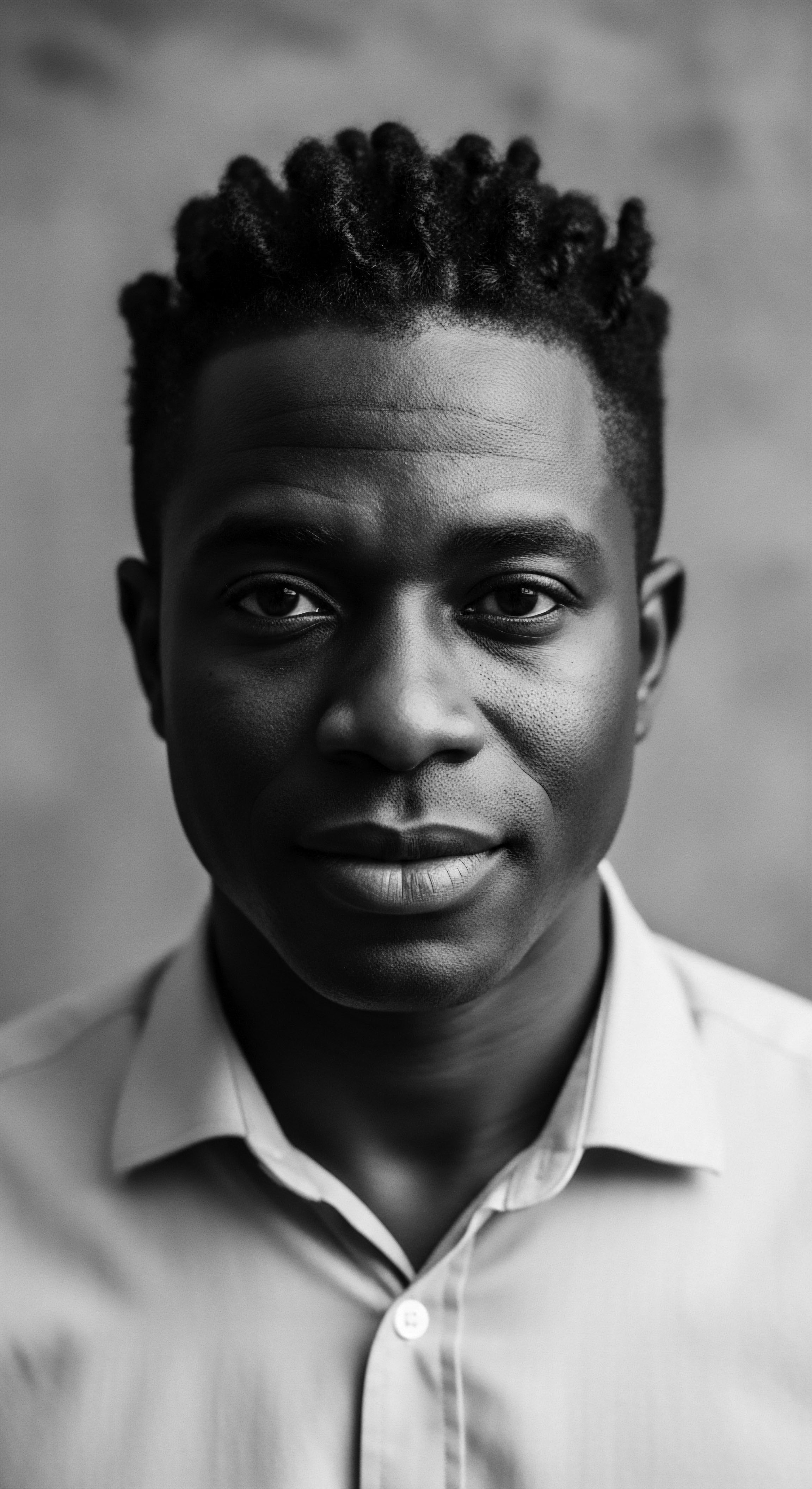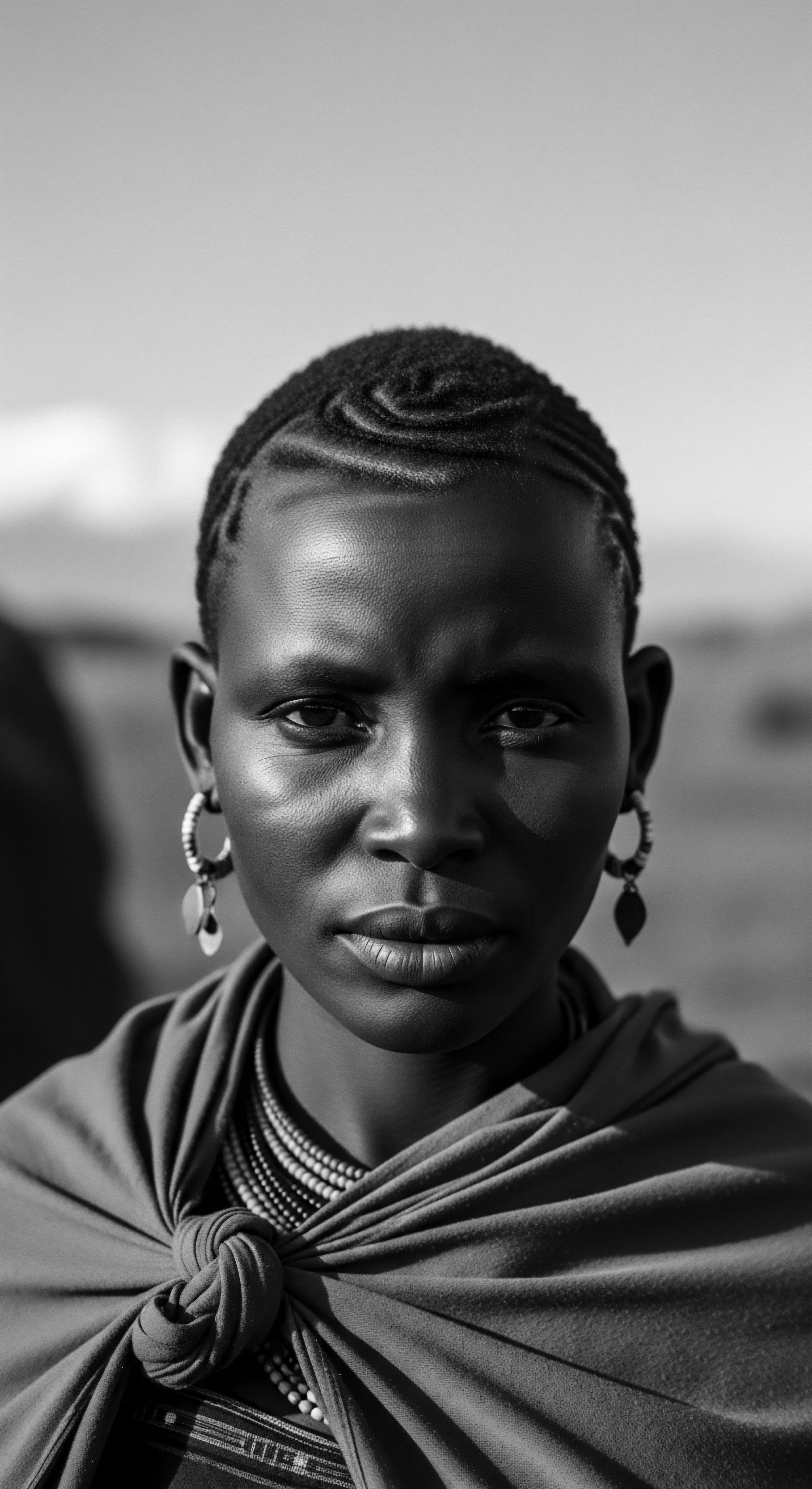
Roots
Consider for a moment the very strands that spring from your scalp. They are not simply protein filaments; they hold within their coiled forms the deep echoes of generations, a testament to journeys both physical and spiritual. These textures, these curls, coils, and waves, carry stories of resilience, of ancestral lands, and of wisdom passed through time.
Our exploration begins here, at the elemental source, delving into how the very sustenance consumed by our forebears contributed to the strength and moisture we celebrate in textured hair today. This is a journey through heritage, a conversation with the past that illuminates the present.

What Historical Dietary Practices Shaped Textured Hair?
For communities across Africa and the vast diaspora, diet was not a mere act of consumption. It was a rhythmic practice, interwoven with the seasons, the land, and communal life. The historical diets of these communities were rich in components that provided a bedrock for robust hair health.
We observe this in the traditional foodways of West Africa, where staples often included a diverse array of grains, legumes, vegetables, and lean proteins. These diets, often prepared through methods that honored nutrient retention, laid down the molecular scaffolding for resilient hair.
In West African societies, for example, before the profound disruption of the transatlantic slave trade, food systems sustained vibrant cultures. People ate whole, unprocessed items, relying on the natural bounty of their surroundings. This dietary approach supplied a spectrum of vitamins, minerals, and healthy fats, each playing a role in the health of the scalp and the structural integrity of hair strands. The deep connection between food grown from the earth and the vitality of the body, including hair, was understood not as a scientific concept, but as an intuitive truth, a lived reality.
The strength and moisture in textured hair today hold ancestral whispers of how our forebears nourished their bodies from the earth.

Anatomy’s Ancestral Connection to Hair Health
The very biology of textured hair, its unique helical shape, demands a constant supply of specific nutrients to maintain its strength and prevent breakage. Each curl, each coil, represents a point of vulnerability if not adequately nourished. Consider the keratinocytes, the cells that make up the hair shaft.
Their robust formation relies heavily on protein, particularly those rich in sulfur-containing amino acids like methionine and cysteine. These are the building blocks, and their presence in historical diets was a direct contribution to hair integrity.
The sebaceous glands, too, play a role. They produce sebum, the scalp’s natural conditioning oil. For textured hair, this natural oil often struggles to travel down the curves of the strand, making external moisture critical. Yet, internal nourishment plays a part in healthy sebum production.
Vitamin A, abundant in many traditional African vegetables, helps regulate this process, ensuring the scalp maintains its own protective layer. When our ancestors consumed these foods, they were, in essence, feeding the very machinery that supported their hair’s inherent needs.
Beyond these, other micronutrients served as vital cofactors. Zinc, found in certain nuts and seeds, assists in hair tissue growth and repair. Iron, plentiful in leafy greens and lean meats, ensures healthy blood circulation to the scalp, providing oxygen and nutrients to the hair follicles. The dietary practices of ancestral communities provided these elements not as isolated supplements, but as part of a balanced, synergistic whole.
| Traditional Food Group Ancient Grains (Fonio, Teff, Sorghum) |
| Key Nutrients Methionine, Cysteine, Iron, Zinc, B Vitamins |
| Hair Health Benefit Protein synthesis for strength, circulation, cell growth |
| Traditional Food Group Leafy Greens (Spinach, Amaranth, Ugu) |
| Key Nutrients Iron, Vitamin A, Vitamin C, Folate |
| Hair Health Benefit Supports circulation, sebum production, collagen formation for strength |
| Traditional Food Group Fatty Fish (Mackerel, Sardines, Catfish) |
| Key Nutrients Omega-3 fatty acids, Protein, Vitamin B12 |
| Hair Health Benefit Anti-inflammatory scalp health, moisture, structural integrity |
| Traditional Food Group Baobab Fruit/Seeds |
| Key Nutrients Vitamins A, C, D, E, K, Omega Fatty Acids, Antioxidants |
| Hair Health Benefit Reduces dryness, promotes growth, strengthens follicles, elasticity |
| Traditional Food Group These dietary components, present in diverse ancestral foodways, illustrate a profound understanding of nourishment for the entire body, including the hair. |
The scientific understanding we possess today often validates what ancestral wisdom knew instinctively. The balanced intake of a wide spectrum of nutrients, inherent in many traditional diets, provided the necessary components for the healthy functioning of hair follicles and the resilience of textured strands.

Ritual
The journey of textured hair through history is one of persistent care, a testament to an inherited wisdom that extends beyond mere aesthetics. Here, the ancestral practices of styling and daily nourishment interweave, revealing how dietary contributions sustained the physical capacity for these traditions. The foods consumed provided the biological foundation for hair that could withstand intricate braiding, frequent manipulation, and the demands of communal life. This section considers how diet supported these enduring rituals.

How Did Dietary Traditions Support Styling Practices?
Consider the elaborate cornrows, the threading, and the complex braids that adorned heads across pre-colonial Africa. These styles, far from being fleeting fashion, carried profound messages of identity, status, and spiritual connection. The ability to create and maintain such intricate styles rested, in part, upon hair that possessed inherent strength and elasticity.
Hair that is brittle, dry, or prone to breakage simply cannot hold these forms. The diets of the time offered specific nutrients that contributed to this resilience.
For instance, proteins from lean meats, fish, and legumes provided the amino acid building blocks for strong keratin, the primary component of hair. The adequate consumption of healthy fats, present in nuts, seeds, and certain plant-based oils, contributed to the hair’s natural luster and moisture retention. These dietary elements meant hair was not just surviving; it was thriving, a canvas ready for the hands of the community to tell its stories.
Ancient diets provided the inner sustenance for hair to become a vibrant canvas for cultural expression.
Even during periods of immense hardship, such as the transatlantic slave trade, where access to traditional foods was severely limited, the echoes of ancestral knowledge persisted. The forced conditions often led to malnutrition and scalp ailments, causing breakage and loss. Yet, the memory of rich, healthy hair, rooted in pre-colonial dietary abundance, continued to shape aspirations for care, even if improvised with limited resources like animal fats or discarded oils. The very desire for nourished hair was an inherited impulse, a whisper from generations past.

The Role of Traditional Processing in Nutrient Delivery
The manner in which foods were prepared also played a significant role in preserving their nutritional integrity, directly influencing the nourishment available for hair. Traditional processing methods, such as fermentation, soaking, and specific cooking techniques, were not accidental; they were the product of generations of accumulated wisdom, often enhancing nutrient bioavailability or reducing anti-nutrients.
For example, the nixtamalization of maize, a practice prevalent in Mesoamerican cultures (and later influential in parts of the diaspora), dramatically increased the bioavailability of niacin (Vitamin B3) and calcium, both vital for cell function and overall health, including that of hair. Similarly, fermentation, a widespread practice across Africa, could enhance the nutritional value of grains and legumes by synthesizing nutrients or deactivating anti-nutrients, making essential proteins and minerals more accessible to the body.
- Grains and Legumes ❉ Often soaked or fermented to break down anti-nutrients and improve mineral absorption, supplying amino acids for protein.
- Leafy Vegetables ❉ Frequently cooked in ways that, while sometimes reducing certain heat-sensitive vitamins, could enhance the accessibility of iron and carotenoids.
- Root Vegetables ❉ Prepared to retain beta-carotene, which the body converts to Vitamin A, crucial for sebum production and hair hydration.
These methods underscore a holistic approach to food. It was not simply about what was eaten, but how it was prepared, a ritualistic step that amplified the dietary contributions to vibrant hair and overall well-being. This deeper understanding of food as medicine, food as beauty, is a fundamental part of the textured hair heritage.

Relay
The legacy of textured hair extends beyond its physical attributes; it is a repository of collective memory, a symbol of identity, and a profound declaration of self. This section delves into the intricate interplay between historical diets, the physiological resilience they conferred, and the cultural implications for textured hair. We trace how this nutritional heritage, often subtle in its influence, contributed to the enduring vitality of hair, allowing it to become a voice for communities through time.

Did Specific Nutritional Deficiencies Alter Hair Health Through History?
To truly grasp the impact of historical diets, we must also consider the profound effects of scarcity. Periods of famine or forced dietary shifts, particularly during the transatlantic slave trade and subsequent systemic deprivations, led to significant nutritional deficiencies within Black communities. These deficiencies had tangible, often severe, consequences for hair health.
Protein-energy malnutrition, for example, could lead to a condition known as kwashiorkor, characterized by irritability, swelling, and changes in skin and hair, including alterations in hair color and texture, making it thin and brittle. Insufficient intake of key micronutrients such as iron, zinc, and various B vitamins (particularly biotin and riboflavin) directly correlated with conditions like telogen effluvium (diffuse hair shedding) and compromised hair growth. The hair, in its very struggle, became a stark visual record of systemic nutritional hardship.
A compelling illustration comes from historical observations in tropical Africa during the 1930s, documented by Cecily Williams. She described children suffering from kwashiorkor, a condition linked to abnormal diets, particularly insufficient weaning foods such as maize. The visual presentation of this condition often included noticeable changes in hair, serving as a biological marker of severe nutrient deprivation. This historical context underscores the deep, often overlooked, biological cost of colonial disruption and forced dietary shifts.

How Does Contemporary Science Affirm Ancient Dietary Wisdom?
Modern nutritional science, with its tools for dissecting molecular pathways and nutrient bioavailability, frequently arrives at conclusions that echo the long-held wisdom of ancestral food practices. The understanding that specific vitamins, minerals, and fatty acids are crucial for hair health is not a new discovery; rather, it is a formal validation of what traditional communities understood implicitly through generations of empirical observation.
Take, for example, the widespread traditional use of baobab fruit and its seeds in African diets. Baobab is a nutritional powerhouse, rich in vitamins A, C, D, E, and K, along with minerals such as calcium, potassium, magnesium, and iron. Modern research confirms these components actively support scalp health, promote collagen formation for hair strength, and provide antioxidant protection against environmental damage. The omega fatty acids found in baobab oil, traditionally used both internally and topically, are now scientifically recognized for their anti-inflammatory properties and ability to improve hair elasticity.
| Traditional Source / Ingredient Baobab Fruit and Seeds |
| Ancestral Use Context Staple food, traditional medicine for general wellness |
| Modern Scientific Link to Hair Health Rich in Vitamins (A, C, E, K), minerals, and fatty acids; supports scalp health, collagen, elasticity, and antioxidant protection |
| Traditional Source / Ingredient Fonio Grain |
| Ancestral Use Context Resilient staple, valued for nutritional density |
| Modern Scientific Link to Hair Health High in methionine and cysteine, sulfur-containing amino acids vital for keratin synthesis and hair growth |
| Traditional Source / Ingredient Sweet Potato Leaves |
| Ancestral Use Context Vegetable and traditional remedy for hair care |
| Modern Scientific Link to Hair Health Contains steroids, terpenoids, polyphenols, vitamins, and minerals; shows antifungal activity and hair growth stimulation |
| Traditional Source / Ingredient The enduring wisdom of ancestral food practices finds powerful affirmation in contemporary scientific understanding of hair biology. |
Similarly, ancient grains like fonio, a staple in West Africa, are notable for their unique amino acid profiles, particularly high levels of methionine and cysteine. These are critical components of keratin, the protein that gives hair its strength. Modern analysis confirms fonio’s exceptional value for hair, skin, and nails. This convergence of historical practice and scientific validation solidifies the deep heritage behind textured hair’s strength.

What Dietary Shifts Have Affected Textured Hair Over Time?
The historical trajectory of dietary practices within Black and mixed-race communities is not static. It reflects profound shifts wrought by migration, colonization, and the imposition of foreign food systems. The transition from diverse, nutrient-dense ancestral diets to diets heavily influenced by processed, refined foods has had a demonstrable impact on overall health, including hair vitality.
The move away from traditional cultivation and preparation methods meant a loss of nutrient retention, and often, the replacement of traditional ingredients with less beneficial alternatives. This dietary acculturation, while a complex process, presents a challenge to the inherent resilience once supported by ancestral eating patterns. The pursuit of “good hair,” often intertwined with Eurocentric beauty standards, historically led to the use of harsh chemical straighteners, which damaged hair and scalp. This external alteration further obscured the inherent strength that could have been nurtured from within through traditional nourishment.
- Indigenous Grains and Tubers ❉ Replaced by refined flours, leading to reduced fiber and micronutrient intake.
- Diverse Plant-Based Proteins ❉ Supplemented or replaced by less varied, sometimes lower-quality, protein sources.
- Traditional Cooking Methods ❉ Displaced by faster, often nutrient-depleting, modern preparation techniques.
Yet, the enduring legacy of textured hair continues. A growing movement seeks to reclaim ancestral foodways, recognizing their powerful contribution to holistic well-being, including the very vitality of hair. This movement understands that nourishing the body from within, with the wisdom of the past, is an act of deep reverence for heritage.

Reflection
As we trace the intertwined paths of historical diets and the enduring vitality of textured hair, a powerful truth emerges ❉ the strength and moisture we observe today are not merely biological happenstance. They are, in a profound way, a living archive of generations who understood the intimate connection between the earth’s bounty and the body’s flourishing. Our strands hold within them the echo of ancient grains, the richness of traditional fats, and the deep wisdom of communities who cultivated wellness from the soil.
This heritage is a luminous thread, guiding us toward a deeper appreciation for the foods that nurtured resilience. It beckons us to look beyond fleeting trends and toward the enduring power of ancestral practices. The vibrant coil, the resilient curl, the deeply moisturized strand—these are not just markers of beauty; they are declarations of a legacy sustained by deep knowledge, a testament to the Soul of a Strand that carries the whispers of the past into a vibrant future.

References
- Clinikally. (2024). Exploring the Benefits of Baobab in Hair Care.
- Evolve Organic Beauty. (2018). Ingredient Focus ❉ Baobab.
- Olukoya, A. A. et al. (2019). Sub-Saharan African Maize-Based Foods ❉ Processing Practices, Challenges and Opportunities.
- IRE Journals. (2024). The Impact of Food Processing Techniques on Nutrient Retention and Bioavailability.
- DatelineHealth Africa. (2025). Top 10 African Foods for Healthy Hair.
- CleanO2. (2023). Why We Love Baobab Extract for Hair Care .
- 1mg. (2022). Sweet potato ❉ Benefits, Precautions and Dosage.
- Oldways. (n.d.). African Heritage Diet.
- Les jardins d’Aissa. (2024). Baobab Oil ❉ Africa’s Ancient Beauty Secret for Radiant Skin and Hair.
- Chadare, F. J. et al. (2015). Baobab Food Products ❉ A Review on their Composition and Nutritional Value.
- Healthline. (2017). 5 Benefits of Farro, A Healthy and Nutritious Ancient Grain.
- Library of Congress. (2021). Heavy is the Head ❉ Evolution of African Hair in America from the 17th c. to the 20th c.
- Pharmacia. (2024). Antifungal activity and hair growth stimulation of purple sweet potato leaf fraction (Ipomoea batatas (L.) Lamk) and its molecular mechanism through androgen receptor inhibition.
- National Archives. (2020). How Enslaved Africans Braided Rice Seeds Into Their Hair & Changed the World.
- Frontiers. (2024). Variations in micronutrient concentrations and retentions in fufu made from yellow-fleshed cassava as a function of genotype and processing methods.
- Healthline. (2024). Health Benefits of 5 Ancient Grains From Africa’s Nutritional Treasure.
- The Times of India. (2025). Hair regrowth diet ❉ 6 foods that can stop thinning of hair.
- Atlantis Press. (n.d.). Hair Tonic Formulation Containing Ethyl Acetate Fraction of Sweet Potato (Ipomoea batatas (L.) Lamk).
- Terra Ingredients. (n.d.). Fonio ❉ An Ancient Grain That’s Packed with Nutrients.
- BLAM UK CIC. (2022). The history of Black Hair.
- African Pride. (n.d.). 4 Surprising Flaxseed Oil Hair Benefits For All Textures.
- Byrdie. (2024). 12 Native American Beauty Secrets.
- house of veda. (2025). Jowar Benefits ❉ A Nutritious Millet for Modern Healthy Living.
- Historical Perspectives on Hair Care and Common Styling Practices in Black Women. (2025).
- OpenEdition Journals. (n.d.). Malnutrition in the history of tropical Africa.
- Guo, E. L. & Katta, R. (2017). Diet and hair loss ❉ effects of nutrient deficiency and supplement use. Dermatology Practical & Conceptual, 7(1), 1-10.
- Bolduc, C. & Shapiro, J. (2001). Hair loss in women. Medical Clinics of North America, 85(3), 677-686.
- MDPI. (2023). What Every Dermatologist Must Know About the History of Black Hair.
- MDPI. (2021). Protective Role of Nutritional Plants Containing Flavonoids in Hair Follicle Disruption ❉ A Review.
- Foodwise. (2020). 10 Foods Native to the Americas.
- WebMD. (2025). Top 10 Foods for Healthy Hair.
- The Times of India. (2024). Foods for Hair ❉ Dull, brittle hair? 7 foods that give shine and strength to hair?
- Carney, J. A. (2001). Black Rice ❉ The African Origins of Rice Cultivation in the Americas. Harvard University Press.
- African American Museum of Iowa. (n.d.). The History of Hair.
